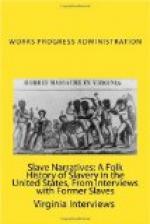I married John R. Jones, a lieutenant in the Union Army, at Gilmer, W. Va., when I was about twenty years old, shortly after the war. We then moved to New Castle, Kentucky, Henry County. We had four children born to us, and I now have three living children; later on in years we moved to Louisville. During the days of the Civil War my father owned three slave, one was an old darkey named Alex, and the nigger mammies, were Diana and Mary Ann. My parents were always good to their slaves, and never traded or sold them. They were good workers and my father never kept many.
My Uncle, John C. Turner, had farms close to my father’s in West Va., and he had fifty-two slaves when the war ended. He would buy, sell and trade them all the time. The slaves were judged by the Masters. If they were big and strong they would bring a good price, as they would be better workers for the fields, and then, I would watch my uncle swap and buy slaves, just the same as he was buying any other stock for his farm. I am getting [HW: old] now, and my memory is not so good no more, and it is hard to remember the things of so long ago. You see, I will be ninety years old, next Feb. 23rd. I was born in 1847.”
Charlie Richmond:
We are unable to interview ex-slaves in Floyd County, so far as anyone we are able to contact knows, there are no living ex-slaves in the County. There are several colored people. The majority of them reside at Tram, Kentucky, Floyd County, in a kind of colored colony, having been placed there just after the Civil War. A small number of colored people live in the vicinity of Wayland, Kentucky, the original being the remains of a wealthy farmer of Civil War day, by name of Martin. The colored people were identified as “Martin’s Niggers.”
The last ex-slave of Floyd County, says Mr. W.S. Wallen of Prestonsburg, Kentucky, was “Uncle” Charlie Richmond, of Prestonsburg. Uncle Charlie was brought to the county by old Judge Richmond, father of I. Richmond of the Richmond Dept. Stores of Prestonsburg, about the time of the Civil War. When the war was over “Uncle” Charlie worked at Richmond’s for hire and lived as a member of the family. While working on a Prestonsburg newspaper, Mr. Wallen interviewed this old ex-slave and worked him into a feature story for his paper. These old paper files were destroyed by fire about 1928.
Mr. Wallen remembers that “Uncle” Charlie Richmond, as the old ex-slave was called, died in 1910, was buried in Prestonsburg, and that he, W.S. Wallen, wrote up the old Darkey’s death and funeral for his newspaper. This is the same paper who’s files were destroyed by fire and which papers does not now exist.
Old Judge Richmond brought this old slave, from Virginia about 1862, along with a number of other slaves. “Uncle” Charlies was the only slave that remained in the family as a servant after the Emancipation Proclamation.




